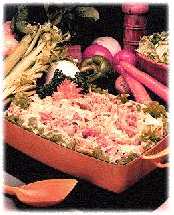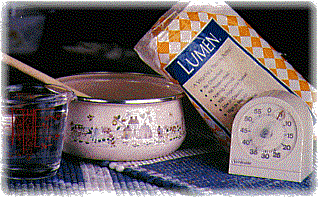

Although many people enjoy eating Heartline right out
of the box (or bag), most do use it for its originally intended
purpose: as a "cooking meat." That is, they want the product to
be used in a finished recipe and resemble meat as
a component of what would otherwise be a real meat dish.
 This calls for reconstituting Heartline first, since
the product comes partially dehydrated to prevent spoilage.
"Reconstitute" simply means that you add water to Heartline
so that it becomes "meat-like." After all, you wouldn't want
roast beef to taste like beef jerky. You expect dinner "meats"
to be firm but tender, not hard and chewy. When you add water
to Heartline and heat the mixture for a few minutes,
you will see Heartline get bigger, softer, and more
tender. That's what you want for your favorite meat recipes.
The two methods we give in the Lumen Book
are the Conventional and Microwave methods.
(Note that the book refers to "Lumen" as the name of the product.
Since 1987 we have referred to our reconstitable "cooking meat"
under its brand name, Heartline).
With small modifications, here are those techniques.
This calls for reconstituting Heartline first, since
the product comes partially dehydrated to prevent spoilage.
"Reconstitute" simply means that you add water to Heartline
so that it becomes "meat-like." After all, you wouldn't want
roast beef to taste like beef jerky. You expect dinner "meats"
to be firm but tender, not hard and chewy. When you add water
to Heartline and heat the mixture for a few minutes,
you will see Heartline get bigger, softer, and more
tender. That's what you want for your favorite meat recipes.
The two methods we give in the Lumen Book
are the Conventional and Microwave methods.
(Note that the book refers to "Lumen" as the name of the product.
Since 1987 we have referred to our reconstitable "cooking meat"
under its brand name, Heartline).
With small modifications, here are those techniques.
|
|
Ideally, different dishes call for different textures of meat. Just remember that the longer you "cook" Heartline in water, the softer it gets and the more water it absorbs -- to a point. Also, if you add more water than directed above, you will reconstitute a little faster, but on the other hand, you will see some flavor loss.
Want to inject some of your own flavors into your Heartline? No problem: just add the flavors you want to add to the reconstitution water and during the rehydration process, Heartline will "pick them up."
Soybeans contain an enzyme called lipoxygenase that impart a
grassy, or "beany" flavor and smell. Some of our customers
add POTATO STARCH, available in most supermarkets,
to the "reconstition water" to minimize any "beany" smell to
the product while cooking. The beaniness only bothers a small
percentage of consumers, but this tip will help those who are
so affected.

 Home Page
Home Page
 Opening
Catalogue Page
Opening
Catalogue Page